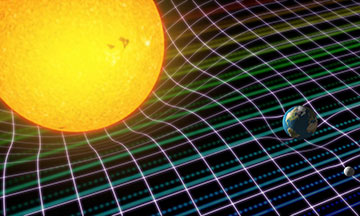
Artist’s representation of the sun, the Earth and the moon (not to scale) with the space–time curvature of Einstein's theory of general relativity over the spectrum of sunlight reflected from the moon (in colors from blue to red). [Image: Gabriel Pérez Díaz, SMM (Instituto de Astrofísica de Canarias).]
A spectrograph designed to search for low-mass planets around distant stars, calibrated with a high-precision laser frequency comb, has measured the solar gravitational redshift predicted by Albert Einstein’s general theory of relativity (Astron. & Astrophys., doi: 10.1051/0004-6361/202038937).
The experiment at one of the European Southern Observatory (ESO) telescopes in Chile is reportedly the most accurate measurement yet of the tiny redshift that gravity imposes on the spectral lines of the sun’s photosphere, and the result adds to the century-old body of evidence supporting Einstein’s theory. The work also helps determine whether the combination of a spectrograph calibrated with a frequency comb over a wide spectral range will exhibit the long-term stability needed to measure the tiny spectral “wobbles” of distant planets.
The HARPS spectrograph
ESO’s 3.6-m telescope at La Silla Observatory, Chile, is coupled to an echelle spectrograph known as the High Accuracy Radial-velocity Planet Searcher, or HARPS. The spectrograph measures the tiny Doppler shifts in a star’s spectrum that occur if (or when) the star and its planet orbit their common center of mass. This so-called radial-velocity method, though indirect, has discovered thousands of extrasolar planets over the past quarter century.
Like other planet-hunting spectrographs, HARPS compares the spectral lines from a target star to a reference spectrum generated on Earth. The ESO instrument uses optical-fiber feeds to observe both a star and a thorium-argon lamp’s spectrum simultaneously.
With the reference lamp, HARPS has discovered more than 130 planets orbiting other stars since it saw “first light” in 2003. Calibration against a laser frequency comb rather than a lamp should improve the spectrograph’s accuracy and precision.
“To detect exoplanets by the radial velocity technique we need precision, not accuracy,” says Jonay I. González Hernández, a scientist at the Instituto de Astrofísica de Canarias (IAC) in Tenerife, Spain. “The precision refers to relative precision with respect to previous measurements, whereas to measure the effect of the solar gravitational redshift, we need accuracy, indeed absolute accuracy of position of spectral lines.”
A decade in the making
González Hernández and his collaborators actually collected the data for the solar gravitation redshift test nearly 10 years ago. He says it simply took him a while to carve out enough free time from his other work to focus his attention on the star at the center of our own solar system.
Through one of HARPS’s fiber feeds, the team collected spectra of sunlight reflected off the moon while the other feed received thousands of equally spaced spectral lines from the laser frequency comb. The comb, linked to an atomic clock, provided about 350 equally spaced lines per spectral order, with the lines within each order having similar intensity. Thorium-argon lamps provide only about 100 lines of varying intensity within each spectral order.
Within the photospheric solar spectrum, the IAC team examined 326 iron lines in the 456- to 590-nm wavelength range, which are well known from published laboratory studies, and compared them with synthetic lines generated from hydrodynamical computer models of the sun.
Einstein’s equations predict that the sun’s gravitational redshift, as seen from Earth, is 633.1 m/s. The IAC team derived a mean redshift of 638 ± 6 m/s.
Exoplanet search
Of course, ESO built HARPS—and a similar system called ESPRESSO at its Very Large Telescope array, also in Chile—to search for exoplanets. According to González Hernández, HARPS has not yet found any planets with comb calibration as opposed to lamp calibration, but he expects that to change in the near future. Depending on the orbital radius of exoplanets around their central stars, Earthbound scientists need multiple years of radial-velocity observations to detect them.
Also contributing to the study were researchers from institutions in Spain, Italy, France and Germany, including frequency-comb pioneer and OSA Honorary Member Theodor W. Hänsch.
